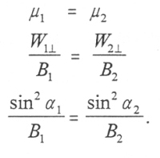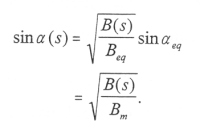Investigation of the Magnetosphere of Ganymede with Galileo's Energetic Particle Detector
Ph.D. dissertation by Shawn M. Stone, University of Kansas,
1999.
Copyright 1999 by Shawn M. Stone. Used with permission.
2.3.1 The First Adiabatic Invariant
The first periodic motion considered is the particle gyration in a magnetic field. Figure 2.6a shows the physical situation. The action integral for this case is

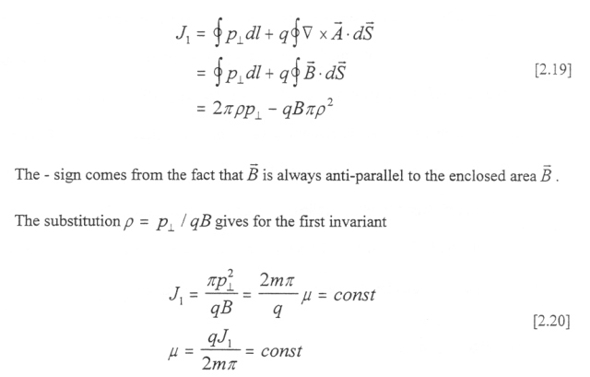
where μ is the magnetic moment of the gyromotion of the particle. Mass m and charge q are assumed constant so μ is the first invariant. The adiabatic invariance of the magnetic moment is valid for both spatially and temporally varying fields as long as they vary on a time scale larger than a gyroperiod.
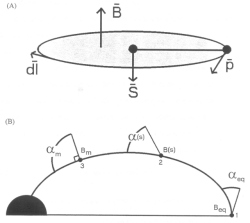 |
Figure 2.6 (A) As a particle gyrates about the magnetic field, its path encloses a surface area πρ2. The area vector is always in the opposite direction of the B vector due to qV x B in the Lorentz force. (B) From the conservation of the first adiabatic invariant it is seen that the pitch angle of the particle increases as it moves from point 1 to 2 to 3 where α=π/2. |
As a consequence of the first invariant, μ=const, the magnetic moment at point 1 (Figure 2.6b) is equal to the magnetic moment at point 2. This leads to a very useful relation using the definition of μ in Equation [2.12]:
|
|
[2.21] |
Equation [2.21] is one of the most useful equations in magnetospheric physics. It allows the calculation of the pitch angle at any position along the field line as long as the magnitude B is known at both points. As a charged particle moves closer to the planet along the field line, the magnitude of the magnetic field increases. To conserve the first invariant, the pitch angle must also increase. The point along the field line where the pitch angle α=90° is called the mirror point, at which B=Bm and ν||=0. From Equation [2.21] and considering the schematic in Figure 2.6b the pitch angle at any point can be calculated in terms of the equatorial values Beq, αeq, or the mirror point values, Bm, αm:
|
|
[2.22] |
Particles that are magnetically trapped may be lost as they bounce between mirror points. A range of pitch angles can be defined from Equation [2.22] in which trapping is not possible because the particles impact a planetary atmosphere or moon and are absorbed. For Earth, the effective edge of the atmosphere can be taken as 100 km [Kennel, 1996; Lyons and Williams, 1984; Parks, 1991] where the magnetic field strength at that point is denoted B100, as shown in Figure 2.7a. Particles with equatorial pitch angles αo <=sin-1(Bo/B100) =αLC have their mirror points at or below the edge of the atmosphere and are quickly lost. Figure 2.7b shows the velocity space representation of the velocity vector for this situation. The shaded region represents the region where a particle with an equatorial pitch angle less than αLC is lost from the distribution of particles. This missing portion of the distribution is called the loss cone [Cravens, 1997].
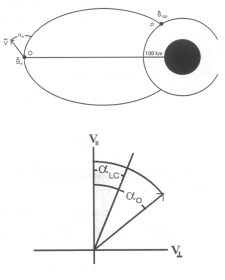 |
Figure 2.7 (A - top) A planet with an atmosphere out to 100 km. A particle at the equator where B=Bo has a pitch angle αo. The value of the magnetic field at the edge of the atmosphere, point P, is B=B100. The minimum pitch angle required for a particle to reach this point is αLC=sin-1(Bo/B100). (B - bottom) The velocity space representation of a particle at point O. Particles with equatorial pitch angles αo within the loss cone (shaded region) mirror beyond the atmospheres edge and are lost from the particle distribution. |
Next: 2.3.2 The Second Adiabatic Invariant
Return to dissertation table of contents page.
Return to main
Galileo Table of Contents Page.
Return to Fundamental
Technologies Home Page.
Updated 8/23/19, Cameron Crane
QUICK FACTS
Mission Duration: Galileo was planned to have a mission duration of around 8 years, but was kept in operation for 13 years, 11 months, and 3 days, until it was destroyed in a controlled impact with Jupiter on September 21, 2003.
Destination: Galileo's destination was Jupiter and its moons, which it orbitted for 7 years, 9 months, and 13 days.




